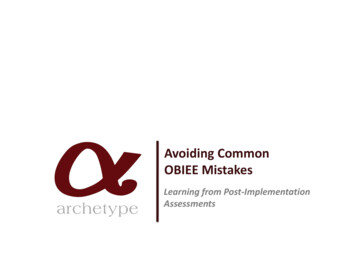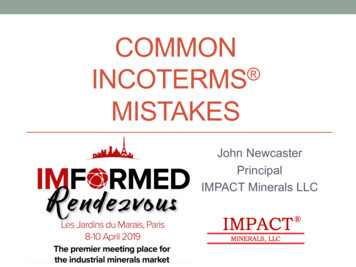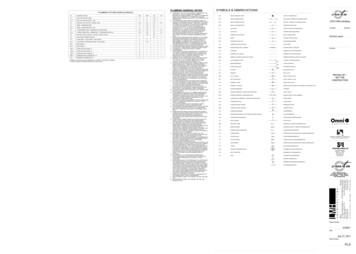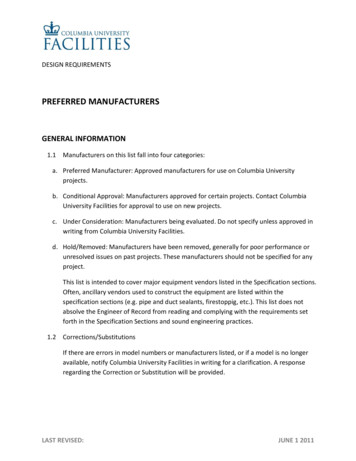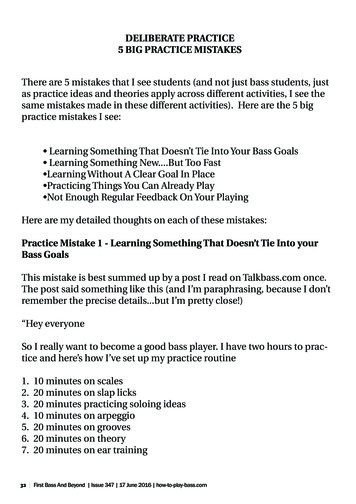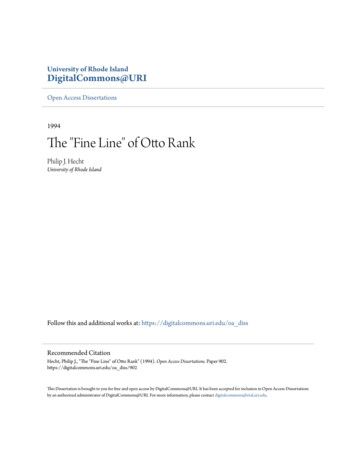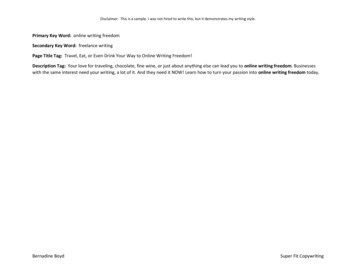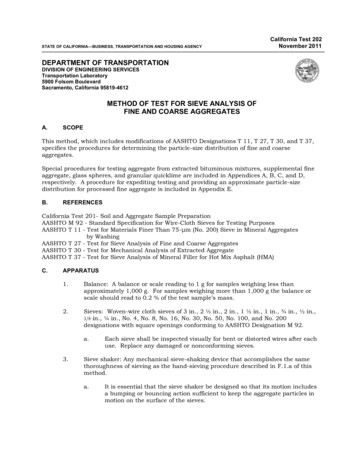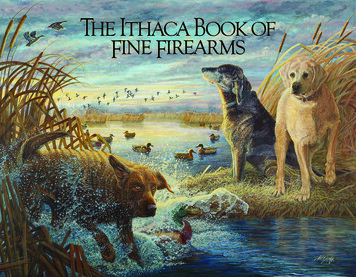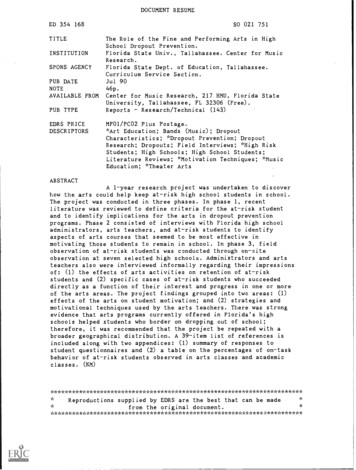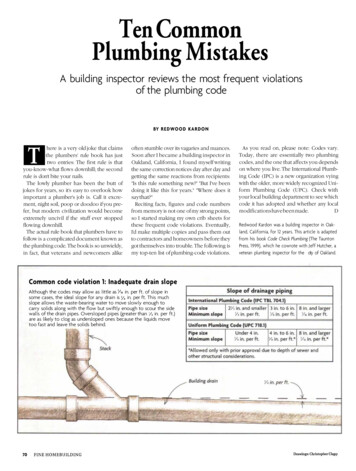
Transcription
Ten CommonPlumbing MistakesA building inspector reviews the most frequent violationsof the plumbing codeBY REDWOOD KARDONThere is a very old joke that claimsthe plumbers' rule book has justtwo entries: The first rule is thatyou-know-what flows downhill; the secondrule is don't bite your nails.The lowly plumber has been the butt ofjokes for years, so it's easy to overlook howimportant a plumber's job is. Call it excrement, night soil, poop or doodoo if you prefer, but modern civilization would becomeextremely uncivil if the stuff ever stoppedflowing downhill.The actual rule book that plumbers have tofollow is a complicated document known asthe plumbing code. The book is so unwieldy,in fact, that veterans and newcomers alikeoften stumble over its vagaries and nuances.Soon after I became a building inspector inOakland, California, I found myself writingthe same correction notices day after day andgetting the same reactions from recipients:"Is this rule something new?" "But I've beendoing it like this for years." "Where does itsay that?"Reciting facts, figures and code numbersfrom memory is not one of my strong points,so I started making my own crib sheets forthese frequent code violations. Eventually,I'd make multiple copies and pass them outto contractors and homeowners before theygot themselves into trouble. The following ismy top-ten list of plumbing-code violations.Common code violation 1: Inadequate drain slopeAlthough the codes may allow as little asin. per ft. of slope insome cases, the ideal slope for any drain is in. per ft. This muchslope allows the waste-bearing water to move slowly enough tocarry solids along with the flow but swiftly enough to scour the sidewalls of the drain pipes. Oversloped pipes (greater than in. per ft.)are as likely to clog as undersloped ones because the liquids movetoo fast and leave the solids behind.As you read on, please note: Codes vary.Today, there are essentially two plumbingcodes, and the one that affects you dependson where you live. The International Plumbing Code (IPC) is a new organization vyingwith the older, more widely recognized Uniform Plumbing Code (UPC). Check withyour local building department to see whichcode it has adopted and whether any localmodifications have been made.DRedwood Kardon was a building inspector in Oakland, California, for 12 years. This article is adaptedfrom his book Code Check Plumbing (The TauntonPress, 1999), which he cowrote with Jeff Hutcher, aveteran plumbing inspector for the city of Oakland.
Violation 2: Unvented trapsTraps and vents are among the most misunderstood concepts in plumbing. The primary function of both isto maintain a sanitary barrier between living spaces and the sewage system. Without a trap to seal offplumbing fixtures, nasty things such as explosive methane gas and vermin can creep into the house. Withoutproper venting, water in the trap can be siphoned out, leaving the trap dry and useless.Violation 3: Flat ventingAll the various methods for venting a trap break down into two categories: wet and dry. A wet vent is an oversizedrain pipe that also serves as a vent. A dry vent is a pipe whose only function is to provide air to the system. Eithertype will fail if it fills up, but wet vents are kept clear by wastewater washing downstream. Water that washes intoan improperly installed dry vent, however, can become trapped along with whateversediment it may be carrying.Violation 4: Horizontal vent below flood rimAny portion of a vent that is below the flood rim of a fixture must be able todrain after it becomes flooded by a clogged drain.
Violation 6: Inaccessible clean-outsViolation 5:Inadequate clean-outsNo matter how well designed or carefully installed they are,drains can still become clogged. Access for cleaning themout must be provided in specific locations, which varydepending on which code is in force.It may sound obvious, but a clean-out that a plumber can't get toisn't much good. Adequate clearance must be maintained to permitservice people to access clean-outs and also have room to work.Where clean-outs are required (UPC 707)KitchenUpperterminal ofhorizontalbranches (Note:Access to clean-outsAny horizontalrun longer thanAllow 18-in. clearance in front of each clean-out. (UPC allows 12-in.clearance for 2-in. and smaller pipe.)UPC 707100 ft. alsorequires aclean-out.)A clean-out isrequired at the junctionbetween the building drain andthe building sewer.Clean-outs in underfloor piping must have 18-in. vertical and30-in. horizontal clearance from the means of access.Clean-outs in underfloor piping must not be more than 20 ft.from the access to the underfloor area.IPC 708Clean-outs are required for any horizontal change ofdirection exceeding 135 (see plan view below)Clean-outOne-eighthbendsto outside of building.Violation 7: Inadequate air gapsA clean-out is required45'Clean-outs in concealed piping, or underfloor piping with lessthan 24-in. vertical clearance, must be extended above floor orbecause this angleexceeds 135 (45 45 45 45 180 ).Where clean-outs are not required Above the first floor Branches 72 or less from the vertical (one-fifth bend) Horizontal branches shorter than 5 ft. long (unless branch serveskitchen sink)Where clean-outs are required (IPC 708) Horizontal branches not more At the base of each stackthan 100 ft. apart Within 10 ft. of connection be Horizontal change of direction tween building drain and sewerexceeding 45 (if more than one P-trap connections with slipchange of direction in a run ofjoints can be used as clean-outspipe, only one clean-out everyas long as they are not more40 ft. required)than one pipe size smaller thanthe drain sizeTo ensure that wastewater cannot be siphoned back into fresh waterlines, a minimum air gap must be maintained between water spoutsand basin flood lines. This violation can occur when tubs are builton site or when imported fixtures are used with domestic sinks. Butthe most common violation is a hand sprayer that does not containa vacuum breaker or automatic antisiphon valve.
Violation 8: Inadequatespace around toiletsand basinsEnough space must be provided so thatlarge people can use toilets and basinswithout discomfort (clearances listedbelow are minimums).Violation 9: Pressure and temperature relief of water heatersimproperly installedIf it had no protective device,a domestic water heaterwhose thermostat failedwould see a continuous risein temperature and pressure.When the pressure exceededthe capacity of the tank (300psi), the tank would burst,expelling superheated waterand shrapnel with explosiveforce. To prevent suchcatastrophic failures, waterheaters are required to beprotected against bothextreme temperature andextreme pressure. This ismost often done with anintegral temperature andpressure-relief valve, which isdesigned to open if eithercondition becomesdangerously high.Violation 10: Inadequate combustion airGas-burning and oilburning appliances requirea specific volume ofairflow for safecombustion. Restrictedairflow can causeincomplete combustion .and poor drafting ofexhaust gases. When thishappens, energy is wasted,the life of the appliance isshortened, and the lives ofthe house's inhabitants areendangered. I mostfrequently encounter thisviolation during abasement remodelingproject, when a furnace orwater heater has beenenclosed in a smallmechanical room with noprovision for makeup air.Supplying combustion aircan be as simple as placinga vent in the wall or ascomplicated as runningmultiple fresh-air ducts toeach appliance. In thisarea, it's wise to consultwith the appliancemanufacturer in additionto the local buildingofficials.SEE ERRATA AT END OF ARTICLE
Erratum: Combustionappliances require twosources of combustion airIronically, we made a mistake in a drawingfor Redwood Kardon's article "Ten Common Plumbing Mistakes" (FHB #126,pp. 70-73). The bottom drawing on p. 73should have included an upper combustion-air source in addition to the lowercombustion-air supply shown. Accordingto code, the upper combustion-air sourcemust be located within the top 12 in. of theroom, ducted to the outside and protectedby an insect-screen cover.
Ten Common Plumbing Mistakes A building inspector reviews the most frequent violations of the plumbing code BY REDWOOD KARDON here is a very old joke that claims
